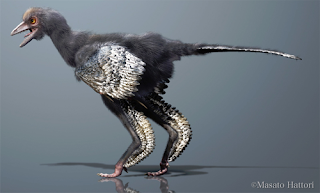 |
| A reconstruction of the new short-armed and winged feathered dinosaur Zhenyuanlong suni from the Early Cretaceous (ca. 125 million years ago) of China is seen in this illustration image provided by the University of Edinburgh on July 15, 2015, Reuters |
xxx
Reuters reports that a new dinosaur fossil has been unearthed in northeastern China. Officially named Zhenyuanlong suni, University of Edinburgh paleontologist Steve Brusatte calls the bird-like meat-eater a "fluffy feathered poodle from hell." Researchers describe the probably flightless dinosaur as afast-running meat-eater was about 6 feet (1.8 meters) long and covered with simple hair-like feathers over much of its body, with large, quill-like feathers on its wings and long tail.Steve Brusatte, one of the discoverers and namer of the dinosaur, is quoted by Reuters:
"If you saw this wing on its own, you would probably think that Zhenyuanlong could fly. But it's a fairly big raptor, and its arms are so short in proportion to its body, that I have a hard time believing that it could fly or glide or do anything in the air," Brusatte said.Among paleontologists there are questions about why wings evolved and when they were first used for flight. "The oldest-known bird, crow-sized Archaeopteryx, lived about 150 million years ago.(Reuters)."
More likely, Brusatte said, Zhenyuanlong used its wings for display the way a peacock uses its tail feathers to attract mates and intimidate rivals. Another possibility is using the wings to brood eggs in the nest...
xxx
 |
| Archaeopteryx. Illustration by Carl Buell, National Geographic |
xxx
The first feather was discovered in 1861 by workers in a German limestone quarry. Paleontologist Hermann von Meyer thought at first it was a forgery. When more evidence of feathered, bird-like dinosaurs was identified by von Meyer, he named his finds Archaeopteryx, meaning 'ancient wing'. Darwin, who had published The Origin of Species two years earlier saw it as hard proof of evolution. At the time many thought of Archaeopteryx as the primary example of bird evolution; since then other pathways have been identified.Now Archaeopteryx is sinking back into the crowd of primitive birds and feathered dinosaurs. As Ed Yong has ably explained, a fresh wave of fossils are coming to light. They reinforce the argument that paleontologists have agreed on for a couple decades now: birds evolved from a lineage of dinosaurs called theropods. But it’s less clear now how exactly Archaeopteryx fits into that evolution. It might still be closely related to the ancestors of living birds, or there might be non-flying theropods that were more closely related. Combine this with the recent discoveries of heavily feathered dinosaurs–feathered down to their feet, in fact–and the possibility emerges that dinosaurs evolved into flyers more than once. We look up in the sky today and see the results of only one of those transitions (Carl Zimmer, National Geographic).
xxx
 |
| Reconstruction of Aurornis xui. Credit: Masato Hattori. National Geographic |
xxx
Discoveries after Archaeopteryx have mostly muddied the water in the search for the first bird and which family of dinosaurs it evolved from. Two articles that discuss the possibilities are The Changing Science of Just-About-Birds and Not-Quite-Birds and New Candidate for World's First Bird.-- Marge

No comments:
Post a Comment